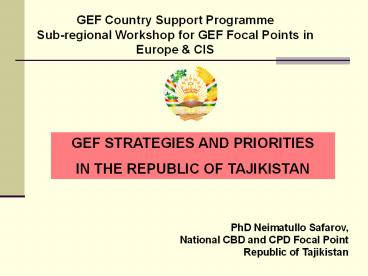GEF STRATEGIES AND PRIORITIES - PowerPoint PPT Presentation
1 / 13
Title:
GEF STRATEGIES AND PRIORITIES
Description:
Taiwan's legislature: Fighting. Voting. British Parliament: 646 members ... Less than 40 members votes are not official. Motion ... – PowerPoint PPT presentation
Number of Views:42
Avg rating:3.0/5.0
Title: GEF STRATEGIES AND PRIORITIES
1
GEF Country Support Programme Sub-regional
Workshop for GEF Focal Points in Europe CIS
GEF STRATEGIES AND PRIORITIES IN THE REPUBLIC OF
TAJIKISTAN
PhD Neimatullo Safarov, National CBD
and CPD Focal Point Republic of Tajikistan
2
Global environmental degradation is the top
priority concern faced by the mankind.
Global environmental pollution, exhaustion
of natural resources, and other environmental
aspects greatly affect human livelihoods,
leading to poverty and forced migration.
3
Mountain area needs specific attention of the
global community
Unique natural resources and the environment of
Tajikistan, availability of a large share of
global gene pool of flora and fauna and their
impact on the environmental and economic
processes are much important in supporting
ecological balance at global, regional and local
levels. Global scales of the environmental
degradation have stipulated the need of uniting
the efforts of all countries to prevent global
ecological disaster and conserve biosphere and,
therefore future of the whole mankind.
4
(No Transcript)
5
State Environmental Program (1997)
Priority Concerns
- conservation and sustainable use of biodiversity
- prevention of land erosion
- reforestation
- sustainable use of natural resources
- energy-saving technologies
- recovery of air and water quality
- improvement of human health
- mainstreaming of environmentally-friendly
industrial - waste management, (including industrial and
mining waste)
6
Multilateral environmental conventions Tajikistan
has ratified or acceded
- The 1997 UN Convention on Biological Diversity
- The 1998 UN Framework Convention on Climate
Change, - The 1997 UN Convention to Combat Desertification,
- The 2002 Stockholm Convention on Persistent
Organic Pollutants (POPs), - The 1996 Vienna Convention for the Protection of
the Ozone Layer, - The 2000 Bonn Convention on the Conservation of
Migratory Species and Wild Animals, - The Convention for the Protection of World
Cultural and Natural Heritage - The 2000 Ramsar Convention on Wetlands,
- The Montreal Protocol on ozone-depleting
substances and its London Amendment (1997) - Aarhus Convention on information access, public
participation in decision-making and access to
justice on environmental issues (2001). - The Cartagena Protocol on Biosafety to the
Convention on Biodiversity (2004).
7
National environmental programs and strategies
- The National Action Plan on Environmental Hygiene
(2000), - The National Action Plan to Combat
Desertification (2001), - The National Program and Action Plan on Phasing
out Ozone Depleting Substances (2001), - The National Strategy on Public Health Protection
(2002), - The National Action Plan for Climate Change
Mitigation, - The First National Report on Climate Change
(2002). - The National Biodiversity Strategy and Action
Plan (2003) - The National Environmental Action Plan (2006)
8
National priority environmental issues of the
Republic of Tajikistan
- Mountain ecosystems and biodiversity
conservation - Biodiversity adaptation to climate change
- Land Degradation
- Biosafety regulatory regime
- Watercourses pollution
- Air pollution
- Greenhouse gas emissions and air pollution
- Waste management
9
Achievements and outcomes gained in the course
of projects implementation funded by GEF
- Improvement of political, legislative and
regulation regime - Poverty alleviation and improvement of community
livelihoods - Development and expansion of national protected
areas network - Land degradation prevention and sustainable
ecosystems management - Reducing environmental pressure and conservation
of fragile mountain ecosystems and arable lands - Strengthening of local capacity for conservation
and use of natural resources - Public awareness raising with respect to
biodiversity conservation - Involvement of local communities and NGOs in
decision-making and environmental activities.
10
National Projects submitted to GEF Secretariat
- Tajikistan Agrobiodiversity and Adaptation
Project - Support the Implementation of the National
Biosafety Framework of the Republic of
Tajikistan - Promotion of Community Forestry in Rural Areas
- Promotion of the Energy Efficiency in Rural Areas
of Tajikistan - Development of the District Heating in the City
of Dushanbe.
11
Priority trends in international environmental
activity in Tajikistan for next decades
- Acceding to mayor international treaties and
their practical implementation - Developing national legislation and regulations
meeting the international legal standards - Screening and applying international expertise
while using environmentally safe and
resource-saving technologies - Attracting investments in the shape of
international technical aid, lax credits and
grants to address national and global
environmental issues - Implicit use of funds provided for environmental
and forestry conservation activities out of all
credit types having productive orientability.
12
National Concerns
- Poor financing
- Weak legislation
- Poor concern of the part of international
organizations - Poor inter-institutional coordination with
respect to environmental issues - Scanty monitoring
- Weak public awareness of main aspects of national
environmental policy in Tajikistan - Weak technical capacity
- Poor possibility of sustainable natural resources
use by rural population - Non-careful attitude of the population toward
natural resources - Lack of consultation and explanatory activity
with rural population.
13
THANK YOU!































